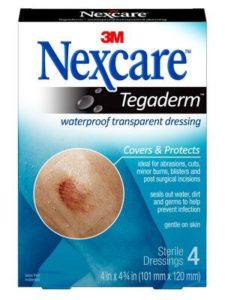How the body heals (Body Piercing)
- The body will begin by sealing the new opening and defending itself with white blood cells and your natural healing factors.
- New skin can grow very quickly when a piercing gets protection from irritation and infection.
- The body heals quickest when protected and left alone, usually in 30 to 90 days
- The better your nutrition and care during this time, the quicker your piercing will heal.
What you need to do (Body Piercing)
- Protect your piercing from biological and chemical contamination. Do not use any antibacterial or antibiotic products, peroxide or alcohol on your body piercing.
- Twisting and turning are not required and have proven to not be useful in healing piercings.
- Check the jewelry regularly and keep the ends tight at their connections. Wash your hands thoroughly, and then use medical gloves, gauze, or folded tissue to grip without direct contact.
- If you are wearing an occlusive bandage such as Tegaderm, ensure that the seal is watertight and replace the dressing when the edges start to peel up or curl.

For you piercing needs
3M NexCare Tegaderm seals are available at your pharmacy
Benefits
- Transparent dressing allows you to easily monitor body piercings without the need to change dressings.
- Dressing conforms to the body for easier application and longer wear time for cost-effective use.
- A unique picture-frame style is easy to apply, allowing for one-handed application and less dressing waste.
- Breathable film allows for the exchange of moisture vapor and oxygen while providing a moist wound environment for enhanced healing.
- The sterile, waterproof dressing provides a barrier to outside contaminants while allowing you to shower.
Your piercing should look good and feel healthy every day.
You should never experience extremes of pain, swelling, redness, heat, discolored discharge or weeping from any piercing. These are signs of a problem. Contact us, or your doctor for advice.
What to expect (Body Piercing)
Phase 1 – (This occurs in the first few weeks.)
- Dry, small scab forms around the jewelry, and skin begin to grow.
- Keep the piercing isolated dry & clean.
- Leave scab or dried fluids intact.
- Don’t touch, move or rotate the jewelry.
- Avoid pressure from tight clothing, or sleeping on your piercing etc., which can cut off the circulation and slow healing.
- Don’t contaminate your piercing with dirty hands, soap, tap water, make up, or skincare products, etc.
- While bathing or swimming, keep the piercing dry. Keep your back to the shower and cover it with a plastic cup, or wear a waterproof seal such as Tegaderm (latex-free).
Prior to applying any bandage over the piercing, clean off the area surrounding the piercing using a gauze pad and distilled water. (Take care to avoid the wound).
- If it gets WET, rinse with clean water and blot dry with sterile gauze or tissue.
- If it gets DIRTY, wash it with a mild antibacterial soap, then rinse and blot dry with sterile gauze or tissue.
- Avoid getting the piercing wet or dirty for faster, easier healing.
- Avoid sexual and oral contact with unhealed piercings.
- Healthy nutrition and avoiding alcohol, smoking, and drugs will benefit your piercing.
- After 30 days, please come in for a free follow up visit.
Phase 2- (Usually occurs after the first week.)
- Healthy people will notice the inside sheds dried scab and cellular waste material; growing new skin is delicate.
- Continue to protect it until the skin is sturdy and has completely healed.
- Jewelry should not be moved or changed at home until solid healthy skin has sealed the area. We can do it for you safely.
Phase 3-(Usually occurs within 30 to 90 days.)
- Usually for a healthy individual by now a tunnel of skin is sturdy & sealed.
- Keep cleansers, shampoo and soaps out of the opening and off the jewelry.
- Blot dry with sterile gauze or tissue after bathing to prevent irritation from moisture retained inside.
- When the skin has become sturdy, you can ease back in to your regular activities.
- Changing jewelry on your own should be easy when the piercing is healed.
Should you take out your jewelry for an extended period of time, reinsertion could become difficult.
The longer the jewelry is left out, the tighter and more difficult reinsertion can be. The elastic nature of skin can make a healed piercing shrink, but not seal shut. We can usually put the jewelry back in for you pretty easily with a guide taper, as soon as possible after you remove it. You get to keep the guide to make it easier for you to change or remove in the future.
Oral Care
- Use a new mechanical toothbrush and bottled water to brush teeth and tongue each day during healing.
- Don’t use toothpaste, mouthwash, peroxides or other oral care products during healing—such products do not aid in healing and may irritate the piercing.
- Drink plenty of cold liquids (ice water, fruit juice and electrolyte drinks). Continue until the area has relaxed back to normal.
- Wash out food particles and residues with bottled water after meals and snacks.
- Ice should be soothing if applied consistently until the muscles involved relax.
- Avoid oral contact with anything irritating: alcohol, smoking, spicy, salty, sugary, or highly acidic food and drink, etc.
Moreover,
Within two weeks of sealing the piercing, change the jewelry to a shorter post to prevent serious tooth damage. A closer fit will reduce wear on teeth and gums. You keep your longer post, as it may be useful.
Skin colored (matte pink) titanium pieces are suggested for disguise and can also be used for healing. However, there are currently no clear or flesh tone plastic pieces that meet ASTM standards for safety or implant certification.


